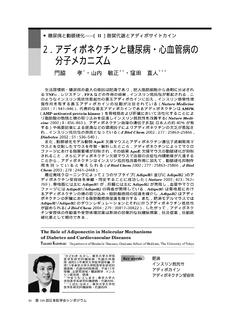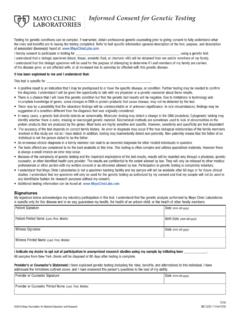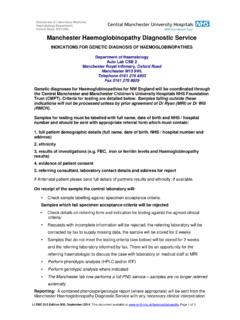Transcription of Guidelines for Genetic Tests and Diagnoses in Medical Practice
1 Guidelines for Genetic Tests and Diagnoses in Medical Practice . The Japanese Association of Medical Sciences (Footnote: This guideline was drafted by representatives of 17 Medical societies including the Japan Society of Human Genetics which had received a request from The Japanese Association of Medical Sciences, and approved on February 18, 2011.). Introduction The progress of Medical genetics has made it possible to clarify the pathogenesis and clinical condition of monogenic (single-gene) diseases based on the identification of the responsible genes.
2 It has also led to the advancement in research aimed at the development of therapeutic strategies. Moreover, research on Medical genetics has brought about broad achievements applicable in the fields of medicine and Medical Practice such as the clarification of Genetic factors associated with the onset of multifactorial disorders, individual variations in pharmacological responses, and so on. The techniques of Genetic Tests and Diagnoses ( Genetic Tests / Diagnoses ) developed in the processes have opened a new era when they can be utilized in all areas of medicine, and provide appropriate selections in the treatments and preventive methods of diseases.
3 In this manner, Genetic Tests / Diagnoses have become one of the most important Medical practices for physicians of all specialties. Meanwhile, special attention needs to be taken in handling Genetic information, since it does not change throughout the individual's lifetime, and could also affect their biological relatives (further referred simply as relatives). An assumption underlying it is that diseases and clinical conditions based upon Genetic variations, and genotypes should be regarded as human diversities and not as rare exceptions.
4 Both human diversity and identity should be respected. The Japanese Association of Medical Science (JAMS) considers that in order to provide better Medical care to the Japanese people, physicians, co-medicals and individuals involved in Genetic medicine should implement Genetic Tests / Diagnoses appropriately and effectively in Medical Practice , giving the highest attention to and thoughtful consideration in the characteristics of Genetic information. JAMS proposes here, in Guidelines for Genetic Tests and Diagnoses in Medical Practice , the basic issues and principals that should be observed when implementing such Genetic Tests / Diagnoses .
5 Since Genetic Tests of diverse diseases and disease-groups have been carried out in a wide range of Medical fields or departments, Genetic Tests include certain points to keep in mind that are unique to each case. Hence, it is recommended that each Medical society that belongs to JAMS should draw up Guidelines or a manual for each disease (group), field or specialty, in accordance with these Guidelines . Physicians and co-medicals involved in Genetic test/diagnosis are requested to pursue appropriate Medical practices according to these Guidelines .
6 Regarding Genetic Tests in research, they should be performed in accordance with the Guidelines related to the research. 1. Scope of these Guidelines These Guidelines shall apply to Genetic Tests of human genome/genes including molecular Genetic Tests (DNA/RNA Tests ), cytogenetic Tests , biochemical Genetic Tests (Note 1), and Diagnoses using Genetic information. The term Genetic Tests in the Guidelines means those analyzing germline alterations such as mutations or chromosomal abnormalities, or those related to germline alterations (Note 2).
7 In Medical Practice , Genetic Tests are carried out not only for the Diagnoses of patients who have already developed a disease, but also for carrier detection, pre-symptomatic diagnosis, Genetic predisposition Tests , pharmacogenetic diagnosis, prenatal diagnosis, and newborn mass screening for congenital metabolic diseases. Meanwhile, the Guidelines do not cover Genetic Tests to identify gene mutations, gene expression, or chromosomal abnormalities which are confined to somatic cells such as cancer cells, because they occur after birth and will not be conveyed to the next generation.
8 However, the Tests and Diagnoses should refer to these Guidelines if there is a possibility that the results could be related to the germline Genetic information of the individual. 2. The characteristics of Genetic information; important issues for Genetic testing and its use in diagnosis Special attention should be paid to the following characteristics of Genetic information when a Genetic test is performed and a diagnosis is made based on the test result. It does not change throughout the individual's lifetime.
9 It is partially shared with biological relatives. Genotype or phenotype of not only the individuals tested (further referred to as examinees) but also their relatives can be predicted with a relatively accurate probability. It is possible to make a diagnosis of non-progressive carriers (who will rarely develop the disease in the future, but possess a mutated gene, and the mutation may possibly be passed down to the next generation). It may be possible to predict the development of disease beforehand with almost 100% accuracy.
10 It may be used for prenatal diagnosis. If it is inappropriately handled or disclosed, it may cause a social disadvantage to the examinees and their relatives. 3. Important points in the Practice of Genetic testing When conducting a Genetic test, it is necessary to understand that important points in the test are different depending on the examinee and the purpose of the test. A list of the explanatory items to be considered at the implementation is shown in Table 1. 3-1) Genetic testing for the Diagnoses of patients who have developed a disease.
















